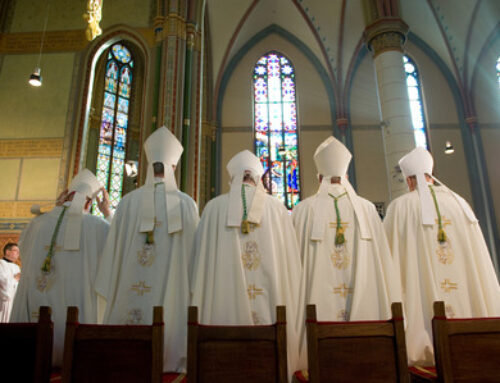
First the scandal. The story notes, with vivid pictures, that 10 out of 34 U.S. Catholic Archbishops live in homes valued at over $1 million. For example:
New York Cardinal Timothy Dolan lives in a 15,000 square foot mansion located on pricey Madison Avenue and valued at $30 million.
Chicago Cardinal Francis George lives on the upper two floors of a $14.3 million mansion in the city’s Gold Coast neighborhood.
Seattle Archbishop James Sartain lives in a three-story dwelling valued at $3.84 million.
Hartford CT Archbishop Leonard Blair lives in a 9,000 square foot mansion valued at $1.85 million.
The list goes on and includes:
Miami Archbishop Thomas Wenski: 5,350 square feet overlooking Key Biscayne, $1.38 million.
St. Louis Archbishop Robert Carlson: 11,000 square feet, $1.4 million. (The Archbishop also owns a home in Florida.)
Baltimore Archbishop William Lori: 11,500 square feet, $1.24 million.
San Antonio Archbishop Gustavo Garcia-Siller: 5000 square feet, 1.1 million.
Most reasonable people will acknowledge that the possession and ostentatious display of great wealth by people of high religious station is a matter of “bad optics”—that is, it doesn’t look good. Not everyone, however, will agree that it rises to the level of scandal. Yet the Catholic Encyclopedia notes that scandal can be either active or passive. The latter form (scandalum datum) exists when someone unintentionally creates an occasion of sin for others.
I submit that bishops who live in mansions invite the sin of envy in others. They can also, and more seriously, lead others to become cynical about the moral leadership of the Church and even the ideal of holiness. What makes the case of the archbishops especially egregious is that the U.S. Conference of Catholic Bishops (USCCB) often issues proclamations on social justice, the redistribution of wealth, and the virtue of sacrificial giving. A few examples:
In 1986 USCCB published Economic Justice for All, which argued that “the concentration of privilege results far more from institutional relationships [that] distribute power and wealth inequitably than from differences in talent or lack of desire to work.”
While serving as President of USCCB (2010-2013) Cardinal Timothy Dolan published True Freedom, which contained this extravagant passage: “If an immigrant from Mexico is a child of God, worth the price of the life of God’s only begotten Son, then we ought to render him or her honor, a welcome and protection in law, not a roar of hate, clenched fists, and gritted teeth in response to the latest campaign slogan from a candidate appealing to the nativistic side of our nature.” (The most obvious “candidate” at the time was Mitt Romney, whose personal contributions to charity, by the way, are by any standard impressive.)
In June, 2014, speaking for USCCB, Bishop Mark Seitz said, “The US and its regional partners must avoid the simplistic approach of addressing the forced migration by forcing children back through increased border enforcement.”
Such pronouncements from a group many of whose members live in luxury could reasonably be regarded as hypocritical. That is not necessarily so, of course. Every bishop who lives in a mansion could conceivably be opening its doors to a few dozen illegal immigrants. If that is the case, may God bless them for their good hearts. However, no such report has to my knowledge found its way to the wire services.
So much for the scandal. Now for the inspiration, which is provided by church leaders who choose to live in modest rather than royal circumstances. For example:
Portland Oregon’s Archbishop Alexander Sample lives in part of a converted convent with his mother.
Cardinal Sean O’Malley moved from the Boston diocesan mansion in 2003 to a modest rectory in South Boston.
Archbishop Charles Chaput sold Philadelphia’s diocesan mansion and chose more modest quarters. (Both Chaput and O’Malley are Franciscans and no doubt realized that the more elegant surroundings would have offended both the founder of their order and the founder’s mentor.)
Most impressive of all is the example of Pope Francis. Although it would be perfectly understandable for him to live in the opulent palace available to Pontiffs, he chooses to live in a small suite in the Vatican guesthouse.
Scandal always makes exciting headlines, but inspiration touches hearts and minds more deeply and lastingly. It is a vivid reminder of Jesus’ condemnation of Pharisees who “tie up heavy burdens and lay them on men’s shoulders, but they themselves are unwilling to move them with so much as a finger,” and His promise that “ Whoever exalts himself shall be humbled; and whoever humbles himself shall be exalted.” (Matthew 23: 1-12)
Thank God for all who live in imitatio Christi, especially those in high office. They set an example for us all.
Copyright © 2014 by Vincent Ryan Ruggiero. All rights reserved



